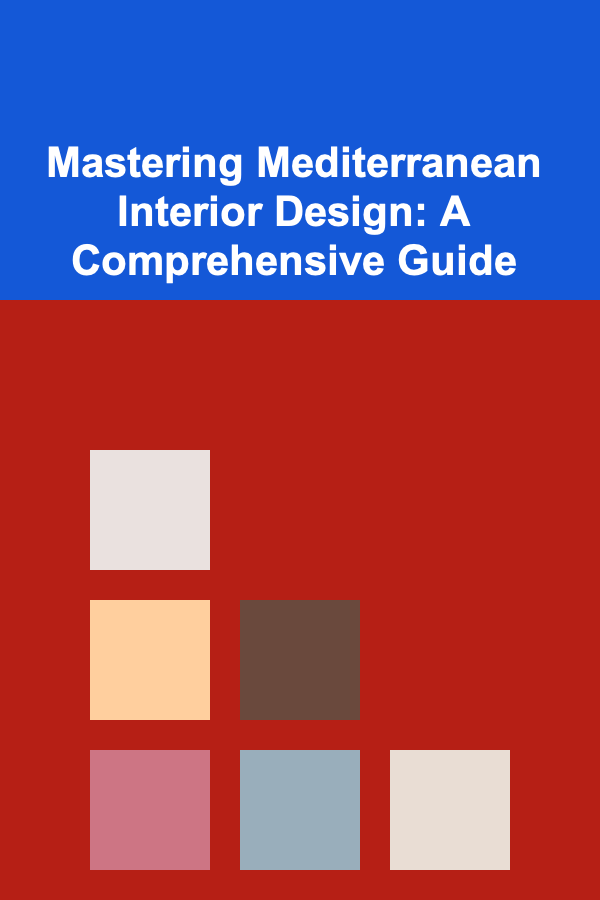
Mastering Mediterranean Interior Design: A Comprehensive Guide
ebook include PDF & Audio bundle (Micro Guide)
$12.99$11.99
Limited Time Offer! Order within the next:

Mediterranean interior design evokes the warmth, charm, and laid-back elegance of coastal regions bordering the Mediterranean Sea. From the sun-drenched shores of Greece and Italy to the vibrant landscapes of Spain and Morocco, this design style draws inspiration from diverse cultures and environments. However, it's not merely about slapping on some blue paint and calling it Mediterranean. Truly mastering this style requires a deep understanding of its core principles, materials, color palettes, and how to blend them seamlessly to create a cohesive and inviting space.
Understanding the Foundations of Mediterranean Design
Before diving into the specifics, it's crucial to grasp the underlying philosophies that define Mediterranean design. It's more than just an aesthetic; it's a lifestyle reflected in the design choices. Key elements include:
- Connection to Nature: The Mediterranean lifestyle is inherently connected to the natural world. Designs prioritize natural light, ventilation, and the use of organic materials. Think sunlight streaming through large windows, breezes flowing through open archways, and textures reminiscent of the earth and sea.
- Simplicity and Functionality: Mediterranean design embraces simplicity. Furniture is often functional and comfortable, prioritizing practicality over ornate decoration. Rooms are designed to be lived in and enjoyed, with a focus on creating a relaxed and welcoming atmosphere.
- Warmth and Hospitality: Mediterranean homes are designed to be welcoming and inviting. The use of warm colors, comfortable seating, and communal spaces encourages gathering and connection. It's a style that fosters a sense of community and relaxation.
- Texture and Tactility: The importance of texture cannot be overstated. Rough-hewn plaster walls, terracotta tiles, woven rugs, and natural fabrics add depth and character to the space, creating a sensory experience.
Understanding these core principles will guide your design choices and ensure that your space feels authentically Mediterranean, rather than just a superficial imitation.
The Essential Elements: Materials and Textures
The choice of materials is paramount in achieving a true Mediterranean aesthetic. These materials contribute significantly to the overall look, feel, and authenticity of the design:
Natural Stone: The Cornerstone of Mediterranean Design
Stone, in its various forms, is a fundamental element. From the rugged textures of limestone to the warm tones of travertine, stone adds a sense of history, durability, and connection to the earth. Consider these applications:
- Flooring: Terracotta tiles are a classic choice, offering a warm, earthy feel. Limestone or marble can also be used for a more elegant and refined look. Consider using different sizes and laying patterns to add visual interest.
- Walls: Exposed stone walls are a striking feature in many Mediterranean homes. If a full stone wall isn't feasible, consider using stone veneer or incorporating stone accents around fireplaces or doorways.
- Outdoor Spaces: Extend the stone theme to patios and courtyards to create a seamless transition between indoor and outdoor living. Stone pathways, fountains, and retaining walls can add to the overall Mediterranean charm.
Wood: Adding Warmth and Character
Wood provides a counterpoint to the coolness of stone, adding warmth and character to the space. Opt for natural, untreated wood or wood with a distressed finish to enhance the rustic appeal.
- Beams: Exposed wooden beams are a signature feature of Mediterranean architecture. They add architectural interest and create a sense of height and spaciousness. Consider using reclaimed wood for a more authentic and sustainable option.
- Furniture: Choose wooden furniture with simple lines and a natural finish. Wicker or rattan furniture can also add to the casual, relaxed vibe.
- Doors and Windows: Wooden doors and window frames can add a touch of warmth and elegance. Consider using solid wood doors with wrought iron hardware for a traditional look.
Plaster: Creating Textured Walls
Textured plaster walls are another hallmark of Mediterranean design. They add depth and visual interest to the space, creating a sense of warmth and character. Consider these options:
- Venetian Plaster: This technique creates a smooth, polished surface with subtle variations in color and texture. It's a more elegant and refined option.
- Lime Wash: Lime wash is a traditional technique that creates a matte, chalky finish with a slightly uneven texture. It's a more rustic and authentic option.
- Tadelakt: Originating from Morocco, Tadelakt is a waterproof plaster technique that creates a smooth, seamless surface. It's often used in bathrooms and kitchens.
Fabric: Softening the Space
Natural fabrics such as linen, cotton, and wool are essential for softening the space and adding comfort. Choose fabrics with a loose weave and a natural texture.
- Curtains: Linen curtains allow natural light to filter through while providing privacy. Choose light and airy fabrics that billow gently in the breeze.
- Upholstery: Opt for durable and comfortable fabrics for upholstery. Consider using slipcovers for easy cleaning and maintenance.
- Rugs: Woven rugs, such as kilims or dhurries, can add warmth and texture to the floor. Choose rugs with geometric patterns or earthy tones.
Metal: Adding Accents and Detail
Wrought iron and other metals can add a touch of elegance and sophistication to Mediterranean design. Use them sparingly as accents and details.
- Lighting Fixtures: Wrought iron chandeliers, sconces, and pendant lights can add a dramatic touch.
- Hardware: Wrought iron door handles, hinges, and cabinet pulls can enhance the traditional look.
- Decorative Accents: Metal planters, sculptures, and mirrors can add a touch of visual interest.
The Mediterranean Color Palette: Capturing the Sun and Sea
The Mediterranean color palette is inspired by the natural landscapes of the region: the sun-drenched beaches, the azure sea, the olive groves, and the terracotta rooftops. The key is to create a harmonious and inviting atmosphere with a blend of warm and cool tones.
The Dominant Hues:
- Whites and Creams: These are the foundation of the Mediterranean color palette. They reflect light and create a sense of spaciousness. Choose warm whites with subtle undertones of yellow or beige.
- Blues: Various shades of blue, from pale azure to deep indigo, evoke the sea and sky. Use blues as accents on walls, furniture, or accessories.
- Terracotta and Earth Tones: These warm, earthy tones add a sense of grounding and connection to nature. Use them on floors, walls, and furniture.
- Greens: Olive green, sage green, and other muted greens represent the olive groves and lush landscapes of the Mediterranean. Use them as accents or in combination with other colors.
- Yellows and Golds: These sunny hues add warmth and vibrancy to the space. Use them sparingly as accents or in combination with other colors.
Consider using a 60-30-10 rule when selecting your color palette. Choose one dominant color for 60% of the space (e.g., walls and large furniture), a secondary color for 30% (e.g., accent walls and upholstery), and an accent color for 10% (e.g., accessories and artwork).
Regional Variations:
The specific colors used in Mediterranean design can vary depending on the region. For example:
- Greek Design: Often features bright white walls with accents of blue, inspired by the iconic white-washed villages of the Greek islands.
- Italian Design: Tend to incorporate warmer earth tones, such as terracotta, ochre, and sienna, reflecting the Tuscan landscape.
- Spanish Design: May include bolder colors, such as reds, oranges, and yellows, influenced by Moorish traditions.
- Moroccan Design: Known for rich, saturated colors like jewel-toned blues, greens, reds and golds alongside intricate patterns.
Research the specific regional styles that appeal to you and adapt the color palette accordingly.
Tip: Use natural light to your advantage. Paint samples on a piece of cardboard and observe them in different lighting conditions throughout the day to see how the colors change.
Furniture and Layout: Creating a Comfortable and Functional Space
Furniture in Mediterranean design should be comfortable, functional, and aesthetically pleasing. The layout should prioritize creating a relaxed and inviting atmosphere.
Key Furniture Pieces:
- Comfortable Seating: Oversized sofas, armchairs, and daybeds are essential for creating a comfortable and inviting living space. Choose furniture with plush cushions and natural fabrics.
- Dining Table: A large dining table is a focal point in many Mediterranean homes, reflecting the importance of communal meals. Choose a table made from solid wood with a natural finish.
- Storage Solutions: Incorporate storage solutions that are both functional and aesthetically pleasing. Consider using built-in shelves, wooden chests, or woven baskets to store items.
- Outdoor Furniture: Extend the living space to the outdoors with comfortable outdoor furniture. Choose furniture that is weather-resistant and complements the overall design.
Layout Considerations:
- Open Floor Plan: Consider an open floor plan to create a sense of spaciousness and connection between different areas of the home.
- Indoor-Outdoor Flow: Maximize the connection between indoor and outdoor living by creating seamless transitions between rooms and outdoor spaces. Use large windows, French doors, or sliding glass doors to bring the outdoors in.
- Focal Points: Create focal points in each room to draw the eye and add visual interest. This could be a fireplace, a large window, a piece of artwork, or a statement furniture piece.
- Comfortable Circulation: Ensure that the layout allows for comfortable circulation throughout the space. Avoid overcrowding furniture and create clear pathways between rooms.
Tip: Don't be afraid to mix and match furniture styles. A blend of traditional and modern pieces can create a unique and personalized look.
Lighting: Illuminating the Mediterranean Spirit
Lighting is a crucial element in creating the right atmosphere in a Mediterranean-inspired space. The goal is to mimic the bright sunshine of the region while providing comfortable and functional lighting for everyday activities.
Prioritizing Natural Light:
Maximize natural light by using large windows, skylights, and light-colored walls and ceilings. Avoid heavy window treatments that block natural light. Instead, opt for sheer curtains or blinds that allow light to filter through while providing privacy.
Layering Artificial Light:
Layering different types of artificial light is essential for creating a well-lit and inviting space. Consider these types of lighting:
- Ambient Lighting: Provides overall illumination for the room. Chandeliers, pendant lights, and recessed lighting can be used for ambient lighting.
- Task Lighting: Provides focused light for specific tasks, such as reading, cooking, or working. Table lamps, floor lamps, and under-cabinet lighting can be used for task lighting.
- Accent Lighting: Highlights specific features of the room, such as artwork, architectural details, or decorative objects. Sconces, spotlights, and track lighting can be used for accent lighting.
Lighting Fixture Styles:
Choose lighting fixtures that complement the overall Mediterranean design. Consider these styles:
- Wrought Iron Fixtures: Add a touch of rustic elegance.
- Ceramic Fixtures: Provide a handcrafted and artisanal feel.
- Lantern-Style Fixtures: Evokes traditional Mediterranean architecture.
Warm Light:
Use warm-toned light bulbs to create a cozy and inviting atmosphere. Avoid harsh, cool-toned lighting, which can feel sterile and unwelcoming.
Tip: Use dimmer switches to adjust the lighting levels throughout the day and create different moods. Dimmer switches are particularly useful in living rooms and bedrooms.
Accessorizing: Adding the Finishing Touches
Accessories are the final touches that bring a Mediterranean-inspired space to life. Choose accessories that reflect the natural beauty and cultural heritage of the region.
Key Accessories:
- Pottery and Ceramics: Display handcrafted pottery and ceramics, such as vases, bowls, and plates. Choose pieces with earthy tones, geometric patterns, or hand-painted designs.
- Textiles: Add texture and warmth with woven rugs, embroidered pillows, and hand-stitched throws. Choose textiles with natural fibers and earthy colors.
- Plants: Bring the outdoors in with potted plants and fresh flowers. Choose plants that are native to the Mediterranean region, such as olive trees, lavender, and rosemary.
- Artwork: Display artwork that reflects the Mediterranean landscape and culture. Consider using paintings, sculptures, and photographs that depict seascapes, olive groves, or historical scenes.
- Mirrors: Use mirrors to reflect light and create a sense of spaciousness. Choose mirrors with ornate frames or distressed finishes.
Avoiding Clutter:
While accessories are important, it's crucial to avoid clutter. Choose a few carefully selected pieces that complement the overall design and avoid overwhelming the space.
Personal Touches:
Add personal touches that reflect your own style and interests. This could include family photos, travel souvenirs, or handmade crafts. The goal is to create a space that feels both authentic and personal.
Tip: Group accessories together to create visual interest. For example, you could group a collection of pottery on a shelf or arrange a vignette of candles, books, and plants on a coffee table.
Regional Variations: Inspiration from Across the Mediterranean
While there are common threads that define Mediterranean interior design, each region bordering the sea has its own distinct character and style. Embracing these variations can lead to a richer and more nuanced interpretation of the aesthetic.
Greek Inspiration:
As mentioned earlier, Greek design is defined by its crisp white walls, vibrant blue accents, and natural stone. Key elements to incorporate include:
- Cycladic Architecture: Replicate the simple, geometric forms of Cycladic architecture with clean lines and minimalist furnishings.
- Pottery and Ceramics: Embrace the artistry of Greek pottery with intricate patterns and earthy tones.
- Outdoor Living: Prioritize outdoor spaces with pergolas, patios, and balconies overlooking the landscape.
Italian Inspiration:
Italian design exudes warmth, elegance, and a touch of rustic charm. Key elements include:
- Tuscan Influence: Incorporate the warmth of Tuscan style with terracotta tiles, exposed brick, and natural wood accents.
- Elegant Furniture: Choose furniture with classic lines and refined details, such as upholstered armchairs and ornate mirrors.
- Culinary Focus: Create a welcoming kitchen and dining area that celebrates Italian cuisine.
Spanish Inspiration:
Spanish design is characterized by its vibrant colors, intricate details, and Moorish influences. Key elements include:
- Andalusian Style: Embrace the boldness of Andalusian style with colorful tiles, wrought iron accents, and geometric patterns.
- Courtyards and Patios: Create a central courtyard or patio as a focal point of the home.
- Religious Art: Incorporate religious artwork and sculptures to reflect the cultural heritage of Spain.
Moroccan Inspiration:
Moroccan design is known for its rich textures, vibrant colors, and intricate patterns. Key elements include:
- Zellige Tiles: Incorporate colorful Zellige tiles to add texture and visual interest.
- Riad Layout: Design the space around a central courtyard with a fountain or garden.
- Textiles and Carpets: Layer textiles and carpets with intricate patterns to create a warm and inviting atmosphere.
By drawing inspiration from these regional variations, you can create a Mediterranean-inspired space that is both authentic and personalized.
Bringing It All Together: Creating a Cohesive Design
Mastering Mediterranean interior design is about more than just choosing the right colors and materials. It's about creating a cohesive design that reflects the spirit and essence of the Mediterranean lifestyle. Here are some final tips to help you bring it all together:
- Start with a Vision: Before you begin, create a clear vision for your space. Gather inspiration from magazines, websites, and travel photos. Define the overall style and atmosphere you want to achieve.
- Create a Mood Board: Compile a mood board with images of colors, materials, furniture, and accessories that you like. This will help you visualize the overall design and ensure that all the elements work together harmoniously.
- Pay Attention to Detail: The details are what make a design truly special. Pay attention to the small things, such as hardware, lighting fixtures, and accessories.
- Don't Be Afraid to Experiment: Mediterranean design is all about individuality. Don't be afraid to experiment with different colors, materials, and styles to create a unique and personalized look.
- Embrace Imperfection: Mediterranean design embraces imperfection. Don't strive for perfection. Instead, embrace the natural textures and irregularities that give the space character and charm.
- Consider Sustainability: Choose sustainable materials and practices wherever possible. This aligns with the Mediterranean ethos of respect for nature and the environment.
By following these guidelines, you can create a Mediterranean-inspired space that is both beautiful and functional, a true reflection of the warmth, charm, and laid-back elegance of the Mediterranean lifestyle. It's an ongoing process, and your home will evolve over time as you add personal touches and adapt the design to your changing needs. Enjoy the journey of creating your own Mediterranean oasis!

How to Find Free Resources for Budgeting Help
Read More
How to Maintain Your Home's Home Theater and Audio Systems
Read More
How to Organize Your Holiday Gift Wrapping Station
Read More
How to Monetize Your Social Media Presence
Read More
How to Interpret Blockchain Privacy Solutions
Read More
Decoding the Silent Language: Understanding Body Language in Dating
Read MoreOther Products

How to Find Free Resources for Budgeting Help
Read More
How to Maintain Your Home's Home Theater and Audio Systems
Read More
How to Organize Your Holiday Gift Wrapping Station
Read More
How to Monetize Your Social Media Presence
Read More
How to Interpret Blockchain Privacy Solutions
Read More